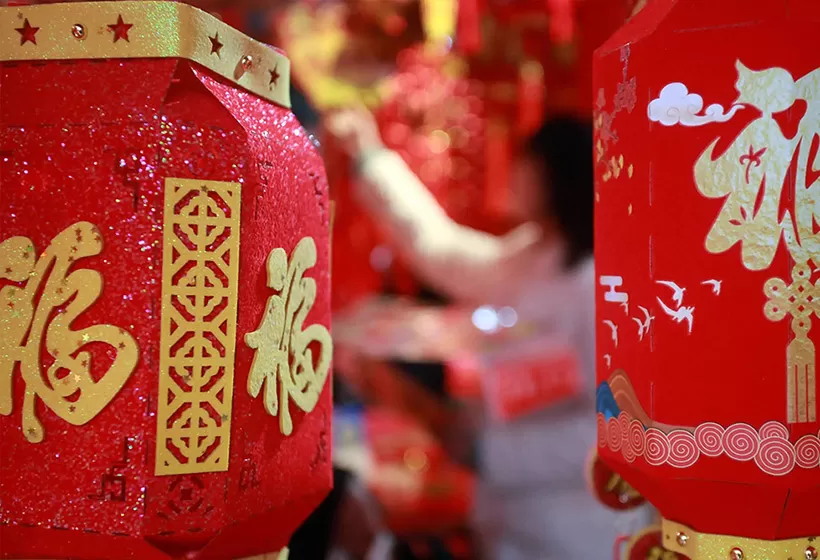Traditional Chinese New Year - Chun Jie
- Names: Spring Festival
- Chinese: 春节 / chūn jié
- When: end of January or beginning of February
- Activities: Pasting couplets, staying up all night to see the new year in, Bainian (pay a New Year call), lucky money, sacrifices, lion dance, dragon dance, etc.
- Holiday: 7 days,
- Travel tips: The Spring Festival is a good time to experience traditional Chinese culture, and it is also the peak time for tourism. Many people choose to celebrate the Spring Festival while traveling. Most southerners like to travel by car. Therefore, hotel prices in southern cities will rise during the Spring Festival, which is similar to the Mid-Autumn Festival.
Introduction to Traditional Chinese New Year
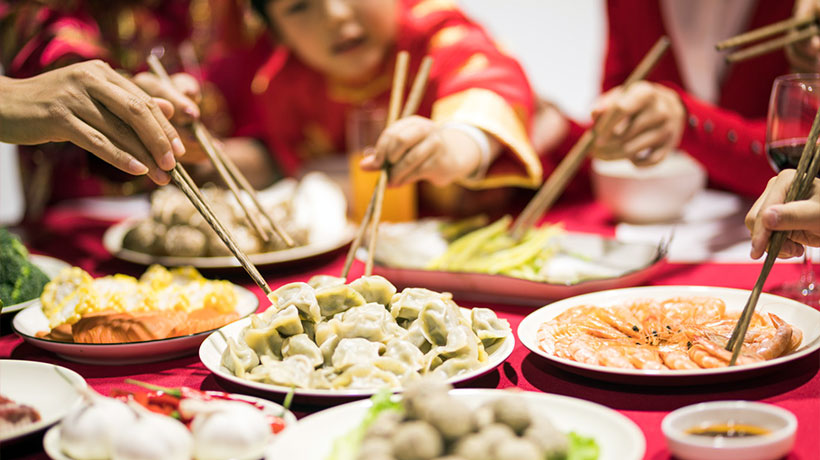
The Chinese New Year, also called Spring Festival, is the most important and widely celebrated festival of all in China. It is celebrated from the 1st day of the 1st lunar month to the 15th day of the 1st lunar month. The final (15th) day is called Lantern Festival, and the night before the 1st day is called Chinese New Year's Eve (Chuxi in Chinese pinyin). This is a time for family reunions, visiting relatives and friends and exchanging greetings for the coming New Year. It is also a time to ring out the old and ring in the new. The Chinese New Year can also be called "Guonian" which means the passing of the old year to the new one. This festival emphasizes the importance of family ties. The dinner gathering on Chinese New Year's Eve is the most important family occasion of the year.
Lunar New Year Calendar and holiday
The traditional Chinese New Year holiday is 7 days, starting from the first day of New Year's Eve to the seventh day, with work starting on the eighth day. If you love Chinese New Year culture, this is the best time to visit China.
| Year | Zodiac | New Year Eve | New Year | Holiday(7 Days) | Lantern Festival |
|---|---|---|---|---|---|
| 2023 | Rabbit | Jan. 21 | Jan. 22 | Jan. 21-27 | Feb. 5 |
| 2024 | Dragon | Feb. 9 | Feb. 10 | Feb. 9-15 | Feb. 24 |
| 2025 | Snake | Jan. 28 | Jan. 29 | Jan. 28-Feb. 3 | Feb. 12 |
| 2026 | Horse | Feb. 16 | Feb. 17 | Feb. 16-22 | Mar. 3 |
| 2027 | Goat | Feb. 5 | Feb. 6 | Feb. 5-11 | Feb. 20 |
| 2028 | Money | Jan. 25 | Jan. 26 | Jan. 25-31 | Feb. 9 |
| 2029 | Rooster | Feb. 12 | Feb. 13 | Feb. 12-18 | Feb. 27 |
| 2030 | Dog | Feb. 2 | Feb. 3 | Feb. 2-8 | Feb. 17 |
| 2031 | Pig | Jan. 22 | Jan. 23 | Jan. 22-28 | Feb. 6 |
| 2032 | Rat | Feb. 10 | Feb. 11 | Feb. 10-16 | Feb. 25 |
| 2033 | Ox | Jan. 30 | Jan. 31 | Jan. 30- Feb. 5 | Feb. 14 |
| 2034 | Tiger | Feb. 18 | Feb. 19 | Feb. 18-24 | Mar. 5 |
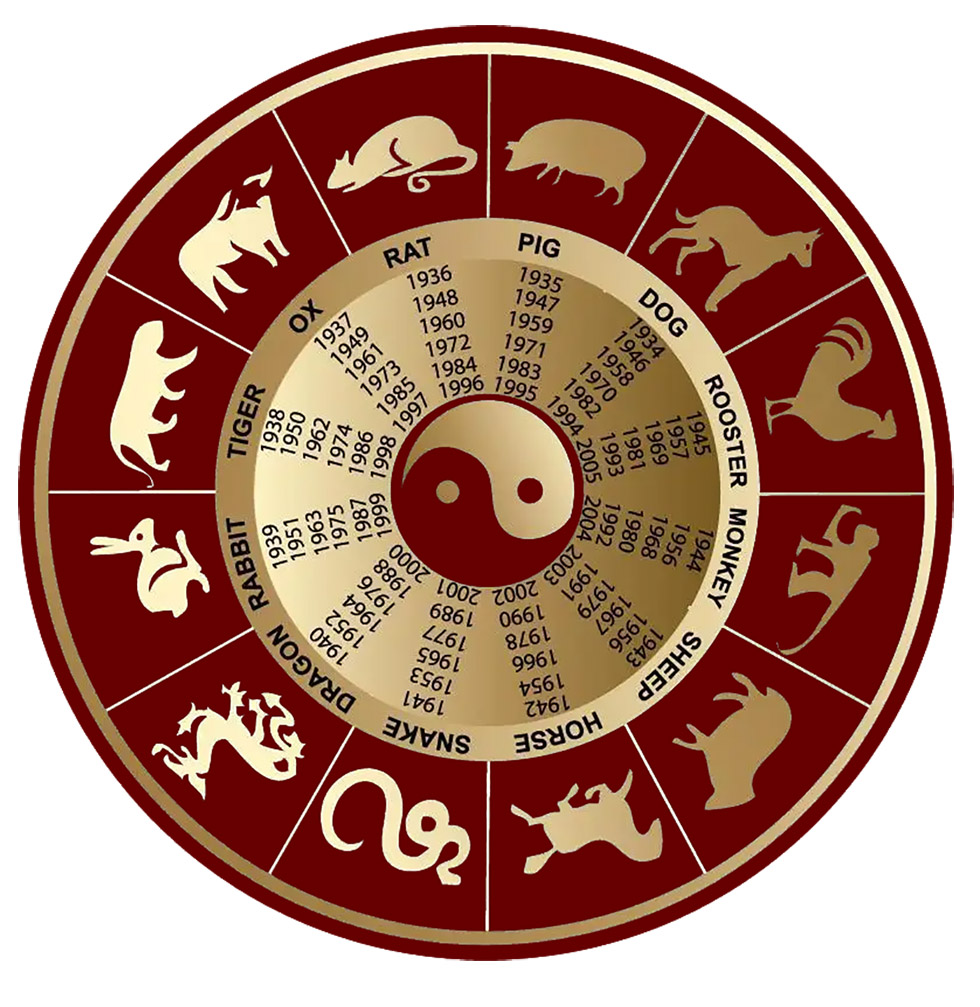 Zodiac Calendar
Zodiac CalendarNote: The tiger is followed by the rabbit, and the cycle continues.
- Avoid the busiest China holidays while planning your China travel
The Origin of Chinese New Year
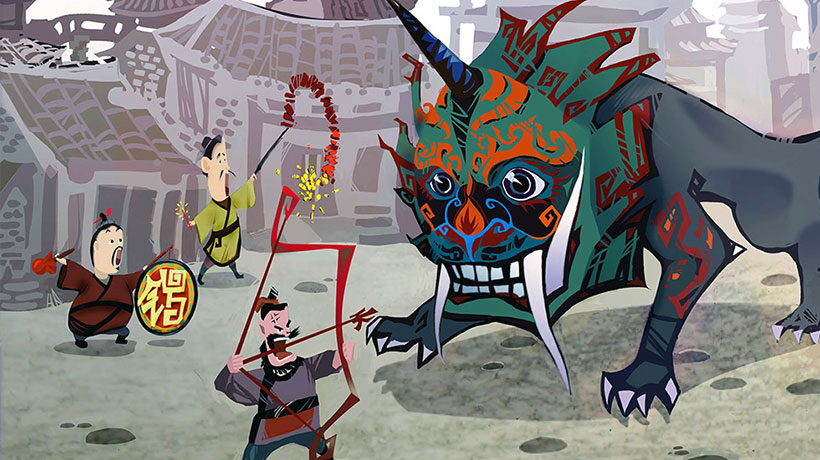
There are several versions of the origin of the Chinese New Year. The most widely heard one is that there was a mythical beast called "Nian" which means "year" in Chinese. Nian always came on the first day of New Year to prey on livestock, crops, and even people. In order to protect themselves, people started putting food in front of their doors at the beginning of every New Year, as they believed that after Nian ate the food prepared for him, he wouldn't eat any of their crops and people. Coincidentally, some people once saw that Nian was scared away by the red clothes worn by a child so they concluded that Nian was afraid of the color red. Therefore, in preparation for the New Year, people began buying new red clothes. Also, they hung red lanterns and red spring couplets on doors and windows. They also lit firecrackers to scare Nian away. From then on, Nian never came back again.
This tradition has been handed down through generations. People still buy many red items in preparation for the New Year: red clothes, red lanterns, red paper cuttings, red spring couplets, red fireworks and firecrackers, and all manner of red objects. So now you know that people don't just feel the color red is exciting or festive, they have a reason to do that!
Related cultural activities you may like
Symbolic Cuisines of Chinese New Year
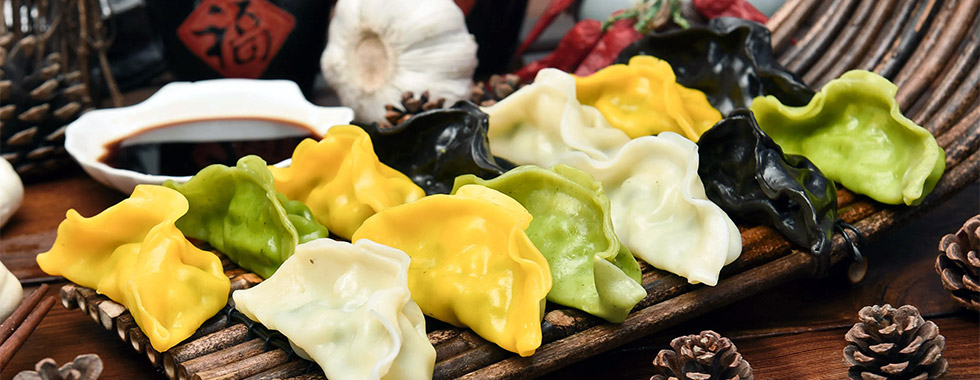
On Chinese New Year's Eve, members of the family, big or small, near or far away, gather for a "reunion dinner". The most common dishes for this dinner are chicken and fish. There are many symbolic foods prepared for the New Year. For example, the fish, "yu" in Chinese pinyin, signifies that there should always be surpluses. Commonly in northern China, "Jiaozi" (dumplings) are made, symbolizing the luck that is wrapped inside. In eastern China, "Nian gao" (Chinese New Year Pudding) is prepared, symbolizing a more prosperous year. People also buy melon seeds, candy, and other seeds.
Related cultural activities you may like
Top Common Practices of Chinese New Year
A few days before the New Year, every corner of the house must be swept and cleaned. This is to wipe away the old and evil spirits. Then, on the eve of the New Year, decorations like red paper cuttings, lanterns, or spring couplets are put up. Written in black ink on large vertical scrolls of red paper, spring couplets are put up on the sides of doors, windows, or other gateways. The couplets are mainly short poems written in classical Chinese, which express good wishes for the family in the coming New Year.
No. 1: Prepare New Year's goods
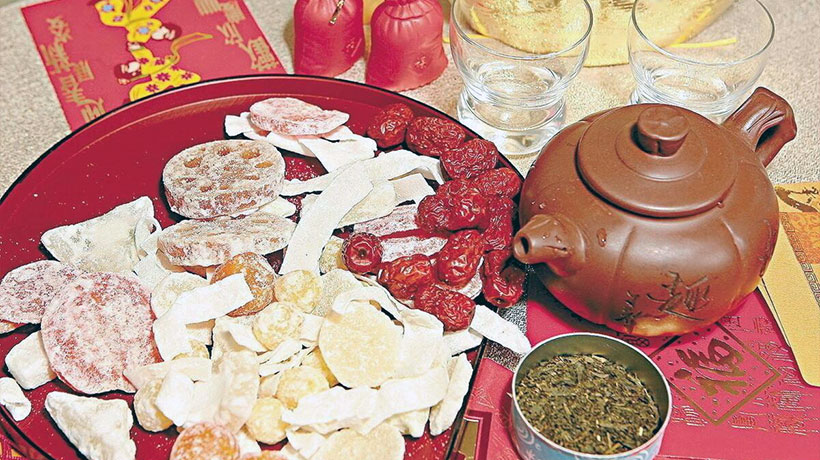
China's New Year custom culture has a long history, and various New Year customs have been derived from all over the country, which is very different from the north to the south, and each has its own characteristics. Although the customs vary from place to place, preparing New Year's goods and giving New Year's gifts are "must-haves" for New Year's Eve almost all over the country. Buying New Year’s goods, including food, clothing, wearing, using, sticking (New Year's red including couplets, blessings/"福" character, door gods, red envelopes, candles, firecrackers, fireworks, etc.), giving (New Year's greetings) gifts, candy, tea, meat, drinks, wine, etc., is collectively called "New Year's goods", and the process of purchasing New Year's goods is called "New Year's goods". Doing New Year's goods is an important activity for Chinese people to celebrate the Spring Festival.
No. 2: House Cleaning
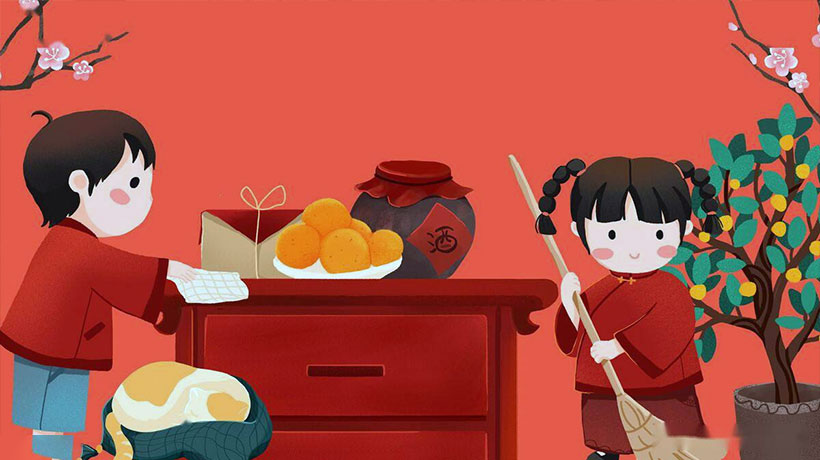
Among the folks, there is a custom of "sweeping the dust (also known as sweeping the house) on the twenty-fourth day of the twelfth lunar month. The folk proverb is called "twenty-four, sweeping the house / 腊月二十四 掸尘扫房子". The folks call it "sweeping the dust day". Clean the environment, wash all kinds of utensils, unpick and wash bedding and curtains, sweep the six-lumen courtyard, brush off the dirt and cobwebs, and dredge the open channels and underground ditches. There is a joyous atmosphere of rejoicing, cleaning, and welcoming the new year. According to folk sayings: Because of the homophony of "dust" and "Chen", sweeping dust before the year has the meaning of "removing old and bringing forth new". The purpose of sweeping dust is to sweep away all bad luck and bad luck, so as to pray for good luck in the coming year.
In the countryside, it is usually necessary to clean the inside and outside of the house, especially the cleaning of your brick and tile house is time-consuming and laborious. In addition, you have to clean the kitchen, pigsty and cattle pen separately. But now many rural families do not raise pigs and cattle, so there is no need for cleaning.
No. 3: New Year's Meat
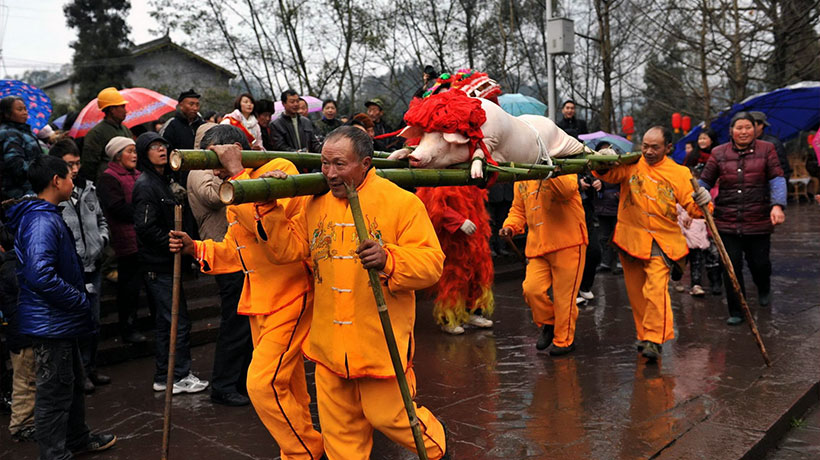
The folk proverb says "on the twenty-sixth day of the twelfth lunar month, kill the pig and cut the meat for the new year / 腊月二十六,杀猪割年肉 ", which means that the meat for the new year is mainly prepared on this day. The so-called slaughter of pigs is of course the killing of pigs raised by one's own family; the so-called cutting of meat refers to the poor people who do not raise pigs going to the market to buy meat for the New Year. The reason why "cutting the meat of the new year" was included in the New Year's Ballad is that the farming society and economy are underdeveloped, and people can only eat meat during the annual festival, so it is called "the meat of the new year".
Nowadays, many rural people don’t raise pigs anymore, and most of them go to the market to buy; some mountainous areas or ethnic minorities kill a pig during the Chinese New Year, some of them are used to give gifts to relatives, some are used to entertain relatives, and some are used to make bacon or sausage.
No. 4: Paste New Year Red
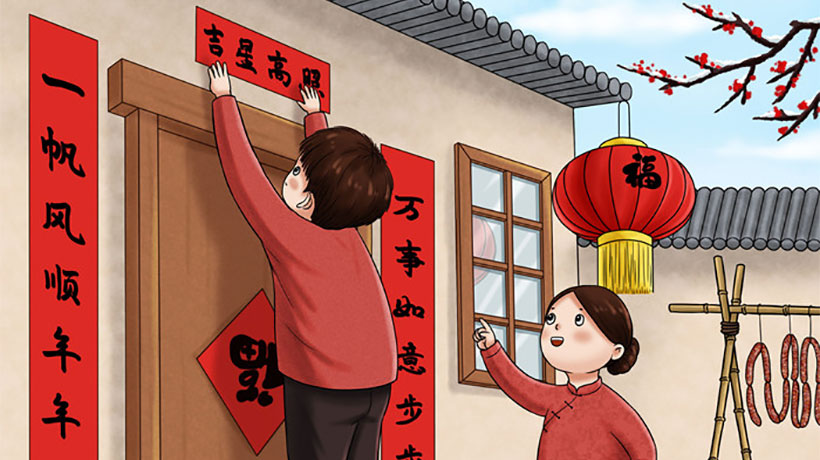
On the 28th, 29th or 30th day of the new year, every household "posts the New Year's Red" (the New Year's Red is the collective name for the red festive elements pasted during the New Year, such as Spring Festival couplets, door gods, horizontal batches, New Year pictures, and the word "Fu"). It is a traditional Chinese New Year custom to paste New Year's red, which adds to the festive atmosphere and places people's good expectations for the New Year and new life.
4.1: Spring Festival Couplets
- Chinese: 春联 / chūn lián
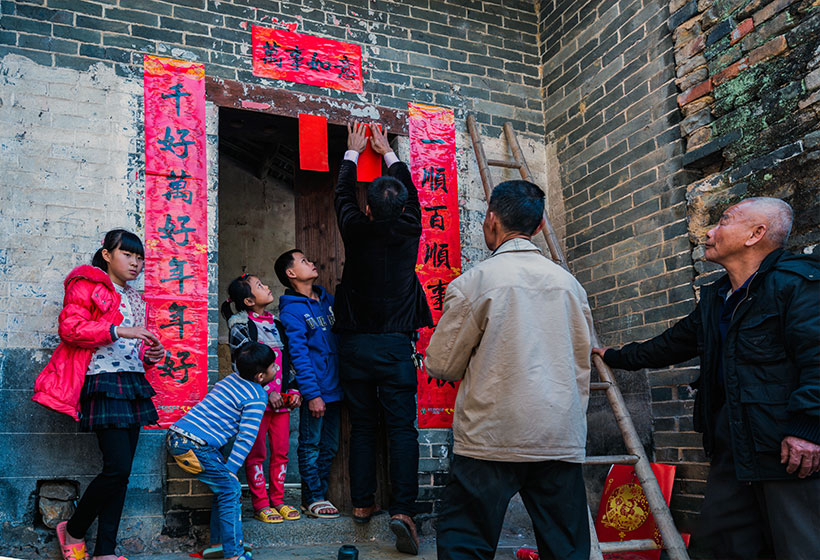 Spring Festival Couplets
Spring Festival CoupletsPasting Spring Festival couplets is also called pasting couplets, etc. It depicts the background of the times and expresses good wishes with neat, dual, concise and delicate characters. It is a unique literary form in China. Every Spring Festival, no matter in the city or in the countryside, every household will choose a red Spring Festival couplet and paste it on the door to add a festive atmosphere to the festival.
4.2: New Year Pictures
- Chinese: 年画 / nián huà
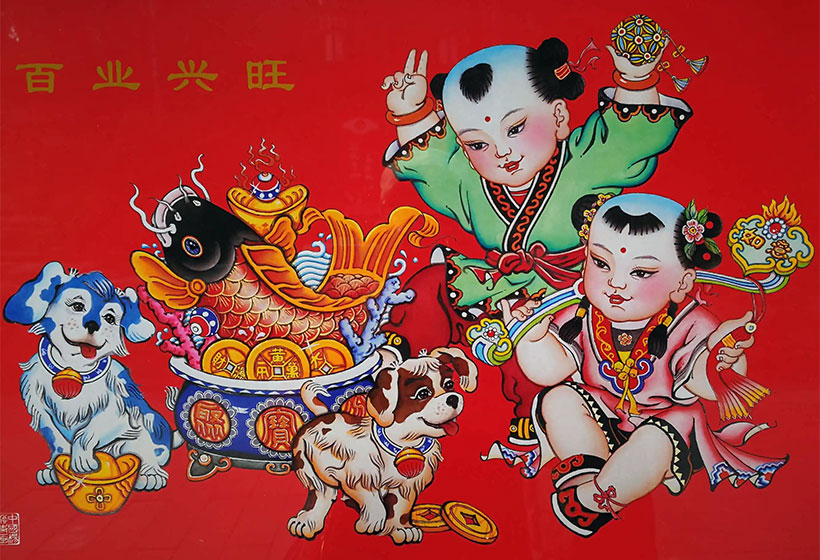 New Year Pictures
New Year PicturesIt is also common to hang and post New Year pictures during the Spring Festival in urban and rural areas. The thick and colorful New Year pictures add a lot of prosperity and joy to thousands of households. New Year pictures are ancient folk art in China, reflecting the people's simple customs and beliefs, and entrusting their hopes for the future. With the rise of woodblock printing, the content of New Year pictures is not limited to monotonous themes such as door gods but has become rich and colorful.
4.3: Paste Paper-cuts to Windows and the word "Fu"/福 (blessing)
- Chinese: 窗花 / chuāng huā 与“福”/ fú
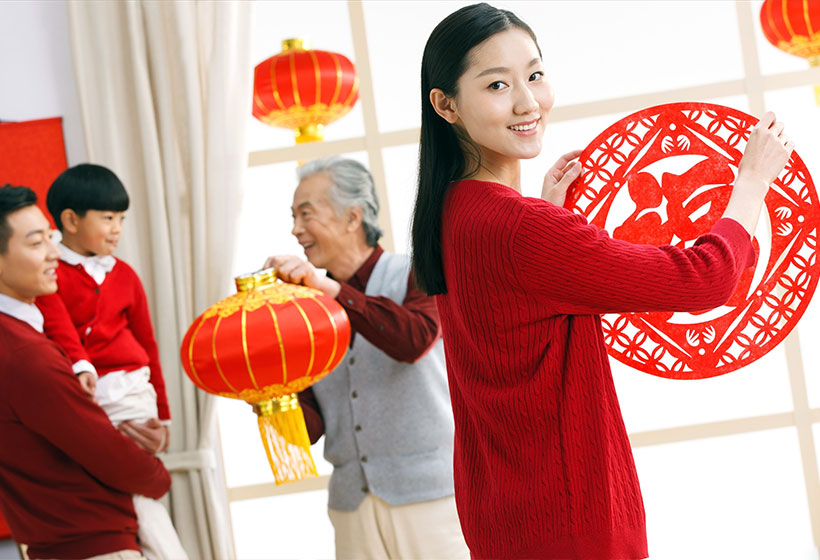 Window Grilles
Window GrillesIn the folk people also like to paste various paper-cuts on the windows - window grilles. Window grilles not only set off the festive atmosphere but also integrate decoration, appreciation, and practicality. At the same time, some families want to paste large and small "blessing" characters on the house door, walls, and lintels. There are also folks who make the word "Fu" into various patterns, such as longevity star, longevity peach, carp jumping over the dragon's gate, five grains and harvest, dragon and phoenix bringing prosperity, and so on.
No.5: New Year's Eve Dinner
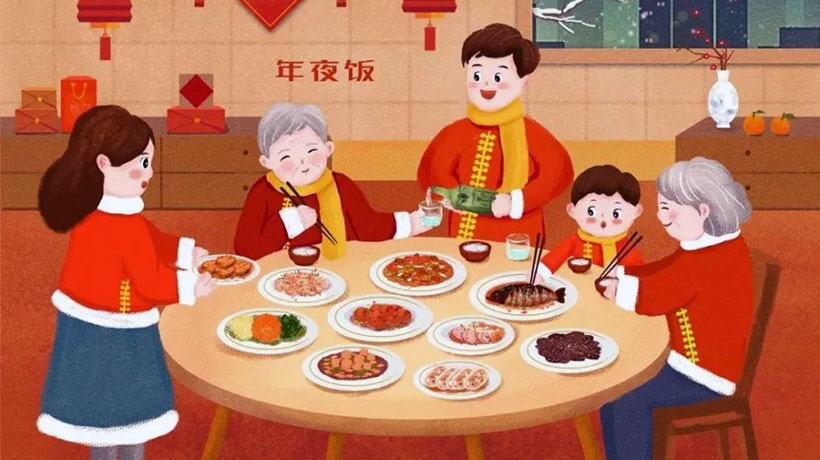
- Chinese: 年夜饭/ nián yè fàn
- When: some families have dinner at 2 or 3 pm, and some have dinner at about 6 pm
New Year's Eve dinner, also known as New Year's dinner, reunion dinner, etc., especially refers to the family dinner at the end of New Year's Eve. The New Year's Eve dinner originated from the ancient year-end sacrificial ceremony, where the family had a reunion dinner after worshiping the gods and ancestors. The New Year's Eve dinner is the highlight of the year, not only rich and colorful but also very meaningful. Before eating the reunion dinner, worship the gods and ancestors first, and the meal will not be served until the worship ceremony is over.
5.1: What do people often prepare for New Year's Eve Dinner?
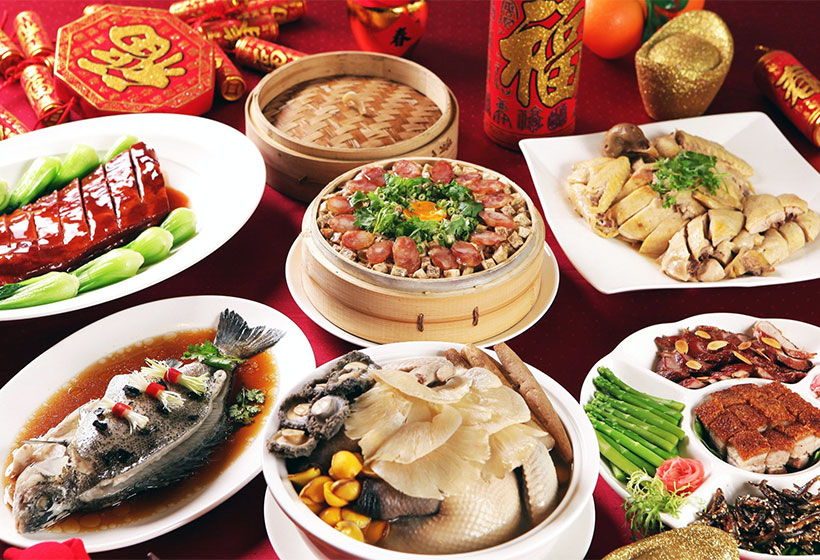 New Year's Eve Dinner
New Year's Eve DinnerThere are usually chickens (meaning planning), fish (meaning surplus every year), dried oysters (meaning good market), bean curd sticks (meaning abundance), lotus root (meaning smartness), lettuce (meaning making money), sausage (meaning long life) ) and so on for good luck. The Chinese New Year's Eve dinner is a reunion dinner for the family, and this is the richest and most important dinner at the end of the year.
5.2: Differences between North and South for New Year's Eve dinner
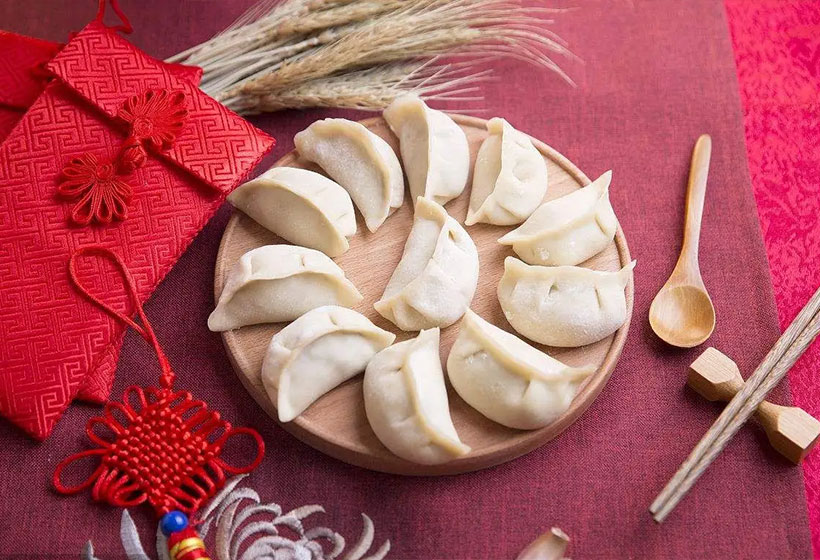 Dumplings for New Year's Eve Dinner
Dumplings for New Year's Eve DinnerThere are many famous places for New Year’s Eve dinners, which are different from the north and the south, and each has its own particularity. Northerners are used to eating dumplings during Chinese New Year, which is a habit handed down from ancient times. Due to geographical and climatic reasons, during the Spring Festival, the north is still in a cold winter, and it is basically impossible to grow crops, with scarce resources and few ingredients. The southern region, especially some coastal areas, is basically full of greenery all year round, and the southern region has a great advantage in vegetables and fruits in winter, so it has more choices in the choice of diet; in terms of geographical advantages, the southern water resources There are plenty of fish and various fish ingredients; so on some important festivals, the diet in the south is more abundant.
However, with the increasing number of large supermarkets and the convenience brought by online shopping and logistics, the difference in ingredients is getting smaller and smaller, and the current differences are only differences in eating habits.
No. 6: Staying Up(Shou Sui)
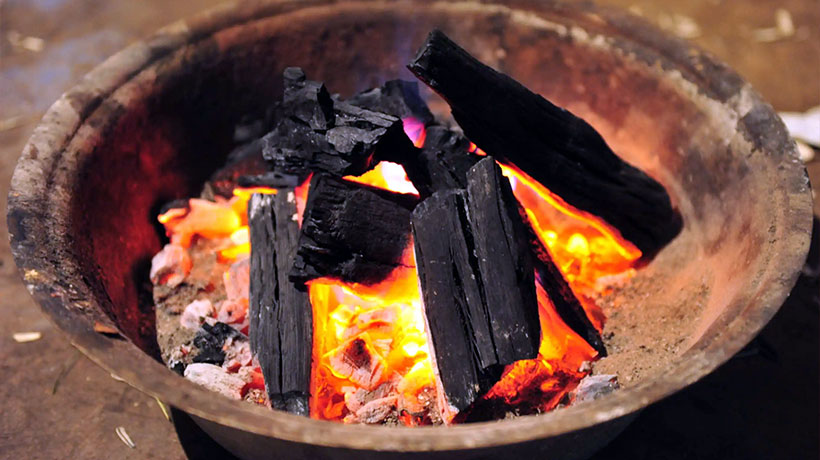
- Chinese: 守岁 / shǒu suì
- Meaning: Shou Sui is the custom of not sleeping on the last night of the old year and staying up late to welcome the arrival of the new year. In ancient times, Shou Sui had two meanings: elders' Shou Sui means "farewell to the old year", meaning to cherish the time; young Shou Sui means to prolong the life of their parents.
- What people do during Shou Sui: watch TV, play on the phone, play mahjong, play poker, set off fireworks or firecrackers, etc.
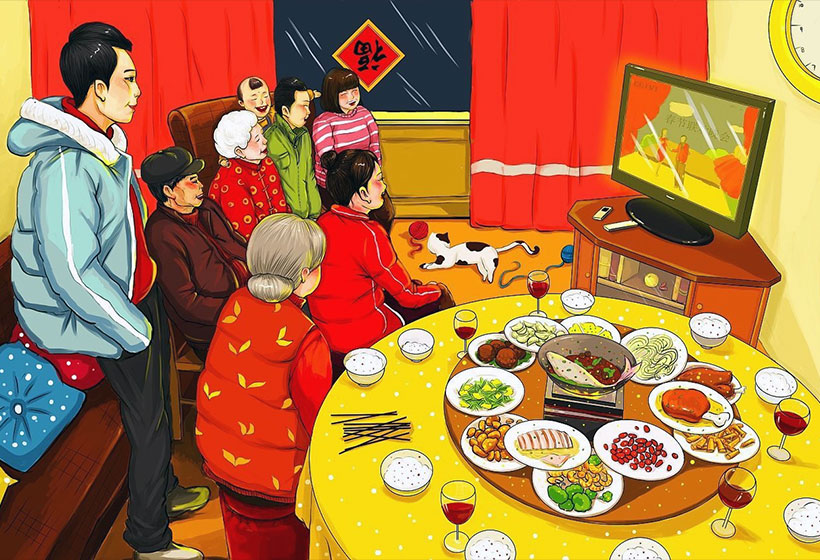 Staying Up with Family Members
Staying Up with Family MembersShou Sui on New Year's Eve is one of the annual activities, and the custom of Shou Sui has been around for a long time. The folk custom of Shou Sui is mainly manifested in that all the houses are lit with new year fires, the family gathers together, and keep the "Shou Sui Fire" from extinguishing, waiting for the moment of saying goodbye to the old and welcoming the new year.
On New Year's Eve, the whole family gathers together, has a New Year’s Eve dinner, lights candles or oil lamps, sits around the fire and chats, and stays up all night to watch, which symbolizes driving away all evil plagues and diseases, and looks forward to good luck in the new year.
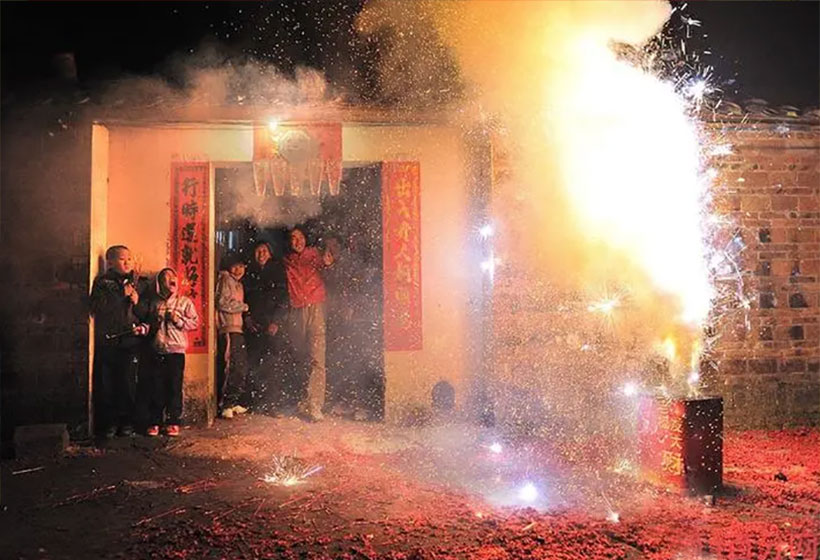 At 12 o'clock in the countryside, many people set off fireworks
At 12 o'clock in the countryside, many people set off fireworksIn the south, usually at 12 o'clock on New Year's Eve, every household in rural areas will set off firecrackers and fireworks on time to welcome the arrival of the New Year. Some families start giving red envelopes(lucky money) to their children after 12 o'clock, hoping that the children will grow up healthily and everything goes well in the New Year!
NO.7: Lucky Money / New Year's Money / Red Envelope
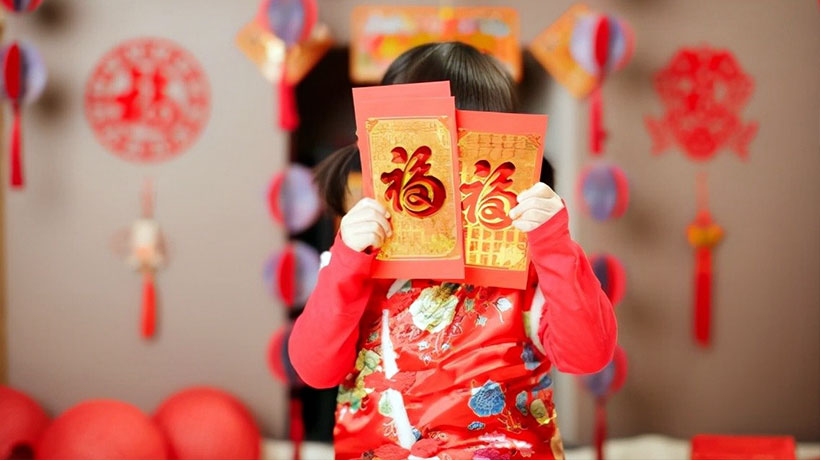
- Chinese: 压岁钱/红包, yā suì qián / hóng bāo
- How much: from RMB10-800 or more
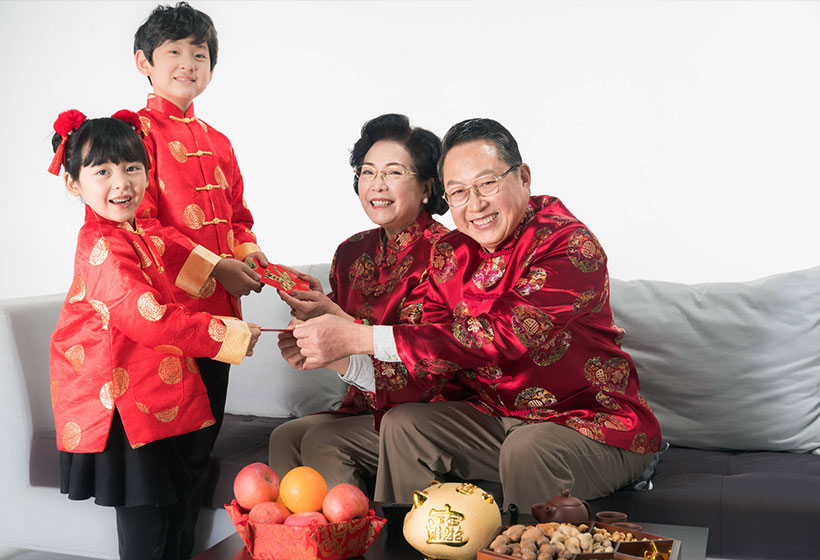 Lucky Money
Lucky MoneyIt is said that "lucky money" can suppress evil spirits, and the younger generation can spend the first year safely with the lucky money. In folk culture, lucky money means to ward off evil spirits and drive away ghosts and bless peace. The original purpose of lucky money was to suppress evil and exorcise evil spirits. Because people think that children are vulnerable to ghosts and ghosts, they use lucky money to drive away ghosts and ghosts.
Generally, during the countdown to the new year, the elders distribute "lucky money" to the younger generations, expressing pressure and embodying the elders' concern and sincere blessings for the younger generation. Another kind of "New Year's money" is given to the elderly by the younger generation in the hope of longevity for the elderly.
No.8: Temple Fair
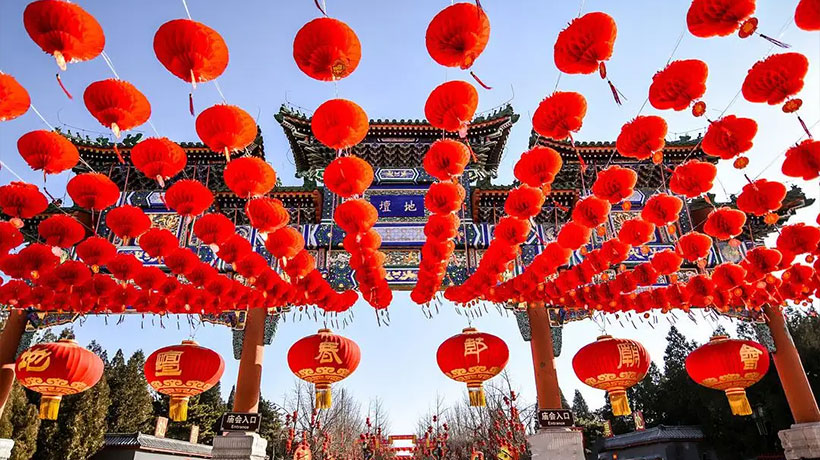
- Chinese: 庙会 / miào huì
- When: from the first day of the New Year to the end of the Lantern Festival, the period varies in different cities.
- Activities: traditional opera, puppet show, comic dialogue, sketch, double reed, magic, Yangko dance, walk on stilts, Diabolo, revolving lantern, rattle, etc.
- Food: Sugar-coated haws, sugar painting, sugar-figure blowing, marshmallow, steamed rice cake, Chinese hamburger(Roujiamo), coold noodles, barbecue skewers, etc.
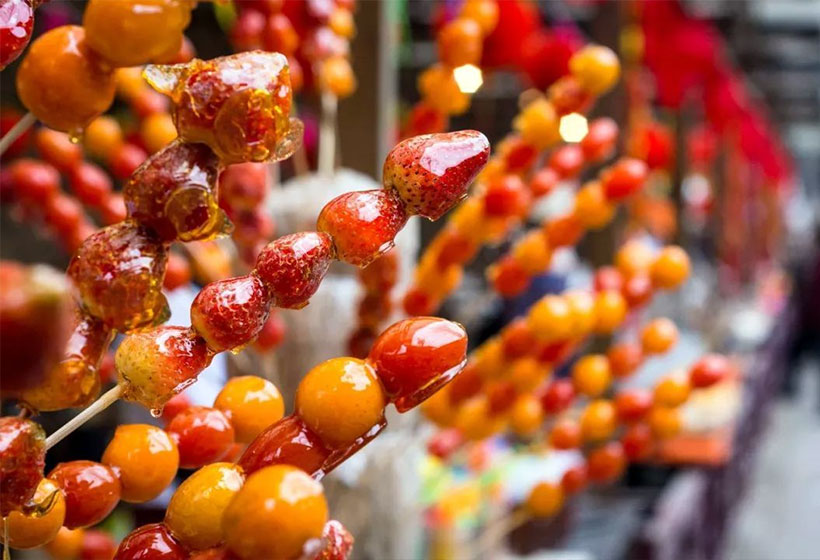 Temple Fair Snacks
Temple Fair SnacksVisiting temple fairs is one of the most lively folk activities during the Spring Festival. Guangfu Temple Fair and Beijing Ditan Temple Fair are also known as the two major temple fairs in China. The content of the temple fair covers puppet collection, Chinese unique skills, martial arts conference, Lantern Festival and other themed activities, and includes rich content such as blessing culture, folk culture, food culture, business and leisure culture.
Visiting temple fairs during the Spring Festival is the most important way to experience Chinese traditional culture.
No. 9: Pay a New Year call
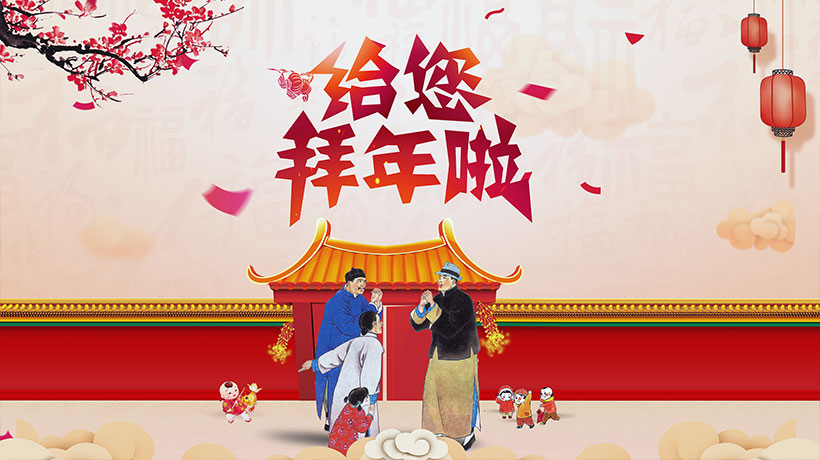
- Chinese: 拜年 / bài nián
Visiting during the Spring Festival is one of the traditional customs of the New Year, and it is a way for people to bid farewell to the old year, welcome the new year and express good wishes to each other. On the second and third days of junior high school, I started to visit relatives and friends, visit each other, congratulate each other, and say congratulations on Xinxi, Gong Xi Fa Cai, Congratulations, and Happy New Year. The meaning of New Year's greetings is to visit relatives and friends to connect with each other, congratulate each other on the New Year, express feelings for relatives and friends and best wishes for life in the new year. With the development of the times, the custom of paying New Year's greetings is constantly adding new content and forms.
There are two types of New Year greetings
1. New Year greetings to brothers, uncles, grandparents and grandma who live in the same place. This kind of New Year greetings do not need to bring gifts, just prepare red envelopes;
2. New Year greetings to uncles, aunts and sisters who are not in the same village. , You need to bring gifts such as milk, wine, chickens and other gifts to celebrate the New Year.
Seasonal food
The Spring Festival is the traditional festival that Chinese people pay the most attention to. On the eve of the Spring Festival, every family will spend a long time preparing for the Spring Festival. So what are the must-eat foods for Spring Festival? Let's take a look below.
Main Dishes
Chiken
Fish
猪蹄
kourou
beef
yangrou
Dumpling
- Chinese: 饺子 / jiǎo zi
Dumplings are an indispensable food for the New Year’s Eve dinner table in the north. Dumplings are shaped like ingots. Eating dumplings during the Spring Festival means “to attract wealth and treasure”. People will also wrap coins in the dumplings. There will be good fortune.
Deserts and Snacks
Desserts and snacks are indispensable in Chinese New Year’s delicacies, such as rice cakes, glutinous rice balls, Steamed sponge cake, Chinese rice pudding, Fried dough twist, Fried flour-coated peanuts, etc., which are loved by children and the elderly.
No. 1: Nian Gao (Rice Cake)
- Chinese: 年糕 / nián gāo
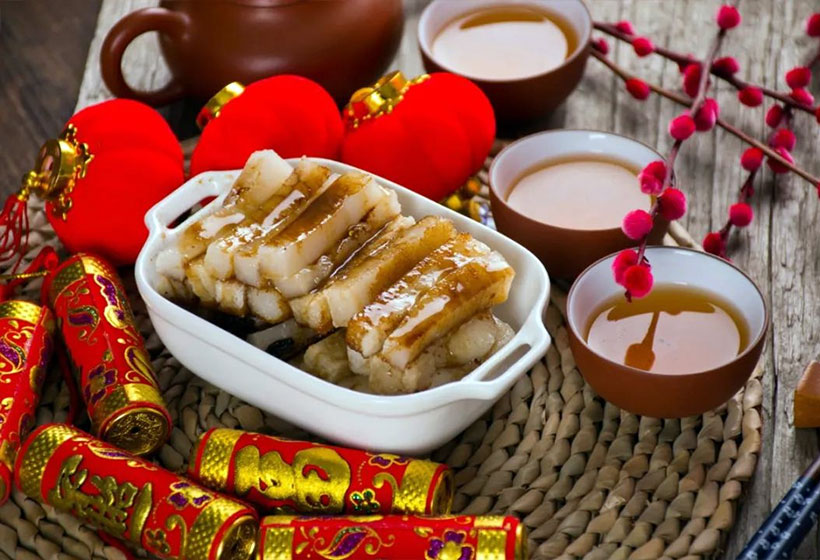 Dragon Dance
Dragon DanceIn the early Suzhou people, to commemorate Wu Zixu(famous military strategist, 559 BC - 484 BC.), they made new year cakes during the Chinese New Year. Later, they gradually became popular all over the country, such as red date rice cakes in Shandong, minced fruit rice cakes in Beijing, taro rice cakes and brown sugar or white sugar rice cakes in Fujian, water-milled rice cakes in Ningbo, and rice cakes in Suzhou. Osmanthus sugar rice cake and so on. Nian Gao, a homonym for "nian gao", is a must-have food for the Spring Festival, and it entrusts people's expectation that everything will develop for the better.
No. 2: Glutinous Rice Ball
- Chinese: 汤圆 / tāng yuán
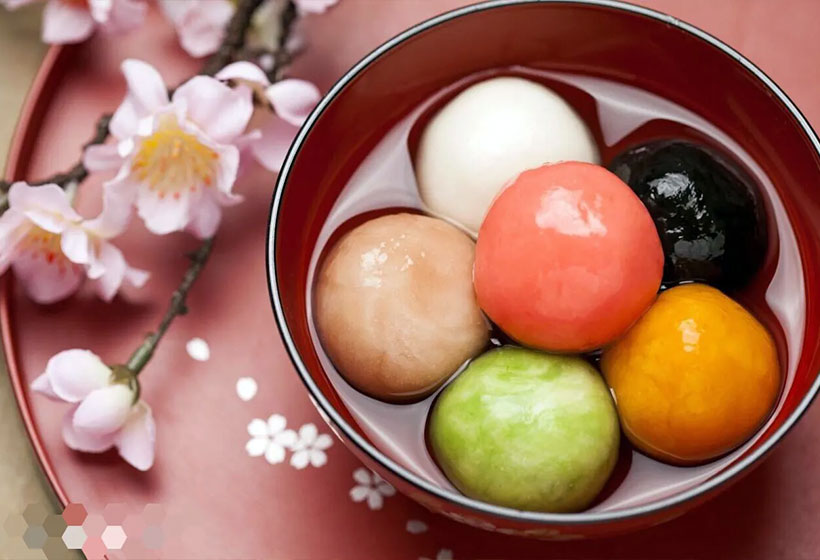 Glutinous Rice Ball
Glutinous Rice BallThe Lantern Festival food in the south is called "Tangyuan", also known as "Yuanxiao", "Tangyuan" and "Floating Yuanzi". It is one of the representatives of traditional Chinese snacks and is a spherical food made of glutinous rice flour. Generally, there are fillings, boiled and eaten with soup. It is also the most distinctive food of the Lantern Festival. Use black sesame seeds and lard as filling, add a little white sugar, and roll the outside into a round shape with glutinous rice flour. Because this kind of glutinous rice dumpling floats and sinks when boiled in a pot, it was first called "Fuyuanzi", and later in some areas, "Fuyuanzi" was renamed Tangtuan. In Jiangsu, Shanghai and other places, there is a custom of eating glutinous rice balls on the morning of the first day of the Lunar New Year.
Red envelopes ("hongbao" in Chinese pinyin) are sold all around the markets and streets. They are used to put money in a red envelope and the money is called "ya sui qian", symbolizing the warding off, or suppression of evil. Usually, adults or older people give red envelopes with any amount of money (it can be 5 yuan or 100 yuan or more) to the juniors. On the cover of the red envelopes, there are usually icons of what the year belongs to or some common greetings like "Xin Nian Kuai Le" (Happy New Year) and "Ji Xiang Ru Yi" (wish everything goes well for you). Some people don't use any red envelopes, instead, they give money to the younger directly.
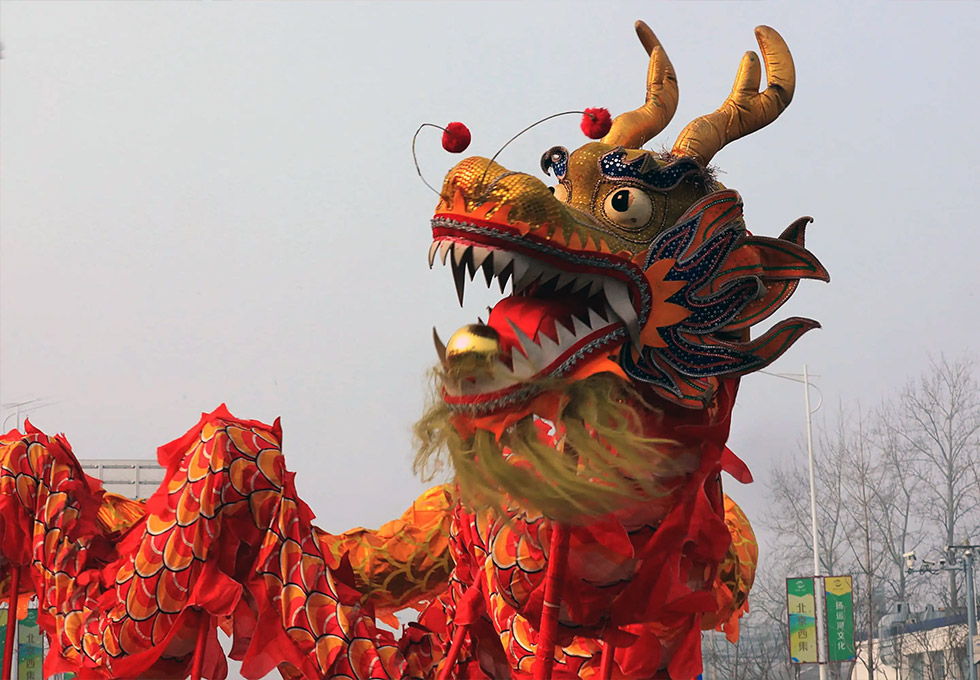 Dragon Dance
Dragon DanceDragon dances and lion dances are very popular and common during the Chinese New Year. From the 1st day of New Year to the 15th day, streets and homes are filled with dragon and lion dances. They are formed by a group of people, some of whom manage the "dragon" and the "lion", while some beat the drums. It is believed that the loud noise created by the drums, along with the faces of the dragon and lion scare away evil spirits.
When the New Year celebration ends on the 15th day of the New Year, there comes the Lantern Festival. On the evening of that day, in some places, people make lanterns and put them into a main river and just let them flow with the currents. In other places, there are lantern parades. People bring lanterns with them and walk on the streets. Young men may highlight the parade with a dragon dance.
Do you know these New Year phrases?
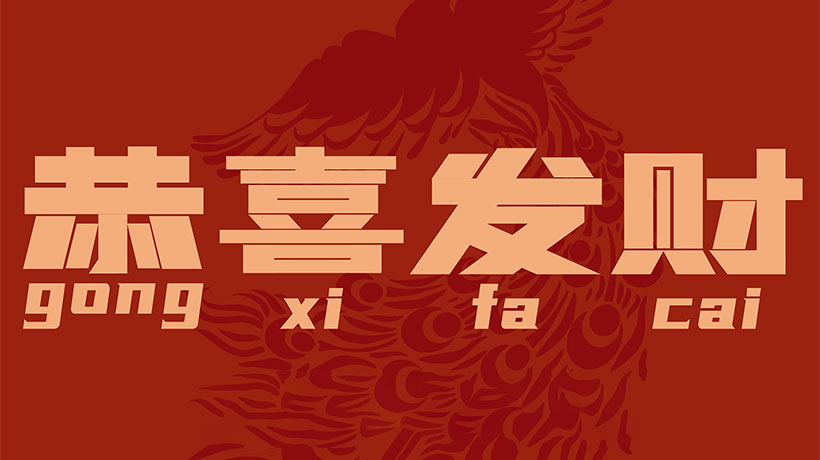
- For everyone you meet: Happy new year! - 新年快乐 /xīn nián kuài lè
- For seniors: Everything goes well and perfect health - 万事如意, 身体健康/ wàn shì rú yì, shēn tǐ jiàn kāng
- For students and young people: May all your wishes come true - 心想事成 / xīn xiǎng shì chéng
- For business people: Wish youa great fortune! - 恭喜发财 / gōng xǐ fā cái
- For business people: Wish your business success - 生意兴隆 / hēng yì xìng lóng
- For those who work: Promoting to a higher position - 步步高升 / bù bù gāo shēng
- Pun: I hope you make a killing and give me a red envelope(New Year's Money)! - 恭喜发财,红包拿来!
Where can I experience the nyear'sear atmosphere and activities?
New Year Travel Itineraries
Related cultural activities you may like
GREAT FAMILY CHINA TOUR
JULY 2024 We wanted to thank Grace at China Culture tour for organizing a great tour of China. We enjoyed our Beijing - Xian-Chengdu -Guilin -Yangshuo - Shanghai trip. Our local guides Bruce in Beijing, Susan in Xian, Jane in Chengdu, Mike in Guilin and Mary in Shanghai took care of us…read more details »
Teng Han L from SINGAPORE
Ready to Create a Unique Dream Travel?
